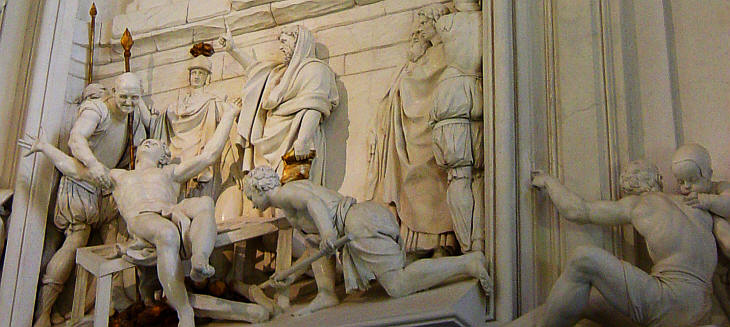The Rosario oratory of Santa Cita is an oratory located in the historic centre of Palermo . It is located in Via Valverde in the La Loggia district , adjacent to the church of Santa Cita. The 17th century building was founded by the homonymous Rosary Company of Santa Cita. It emphasizes the scheme of the oratory as a place of assembly and worship, with a liturgical and social function and with a clear architectural contrast between the obviously modest exterior and the adorned interior.
The high altar built between the end of the eighteenth century and the early nineteenth century, in neoclassical marble style bearing the monograms of the Virgin and Christ, delimited by precious cantories , is enriched with the beautiful painting by Carlo Maratta depicting the Madonna del Rosario (1695). The painting on canvas inserted within an elegant wooden frame sculpted by Pietro Navarrino, brings together in a pyramidal exhibition the Virgin Mary surrounded by Saint Dominic , Saint Catherine of Siena , Saint Vincent Ferreri , Santa Rosalia and Sant’Oliva . The quadrangular presbyterial basin was decorated by the Serpotta between 1717 and 1718 with the addition of two statues representing Judith and Esther . The intervention was considered necessary to enhance the magnificent canvas painted by Maratta. Along the perimeter of the Oratory there are wooden benches inlaid ebony of mother-of-pearl on which the confreres sat to attend religious ceremonies and meetings.
It is accessed through a small portal surmounted by a marble shield that leads through a staircase to the majolica gallery on which two marble portals in late Renaissance style look out. A large anti-oratory, which exhibits numerous portraits of the company’s superiors, leads to the oratory, entirely decorated by Giacomo Serpotta between 1686 and 1718.
The oratory, created with the aim of enhancing the intervention of Our Lady in the struggle between Christians and infidels, entrusts to the decoration the task of representing and propagating in an evident and persuasive way the institutional aims to which, as a religious organism, it is in charge.
Serpotta, in charge of decorating the vast environment in stucco, inserted many angels and cherubs with extremely free and plastic expressions and positions that seem to play with each other, climbing the window frame, peeping out of floral garlands, turning irreverently backwards. . The cupids are crying, sleeping, buckle their hands around her knees deep in thought.
On the wall of the counter-façade there is a very wide drapery, supported by a joyous crowd of putti, in the centre of which is represented the historic battle of Lepanto , a rhetoric celebration of the victory of the Faith (Christians) on the unbelievers (the Muslim Turks). On the sides are depicted two emaciated young men, a symbol of the horrors that war can cause.


The Battle of Lepanto
All around are represented the Mysteries of the Rosary through a refined plastic cycle, composed of putti, allegorical statues and theatres.
Joyous Mysteries (left wall): Annunciation , Visitation , Nativity , Presentation at the temple and outside the triumphal arch, in prospect, the Finding of Jesus at the Temple of Jesus among the Doctors .
Painful Mysteries (right wall): Jesus in the Getemane Garden , Flagellation , Crowning with Thorns , Calvary and on the outside of the triumphal arch, in elevation, the Crucifixion .
Glorious Mysteries (bottom wall, starting from the bottom left): Resurrection, Ascension, Descent of the Holy Spirit , Assumption of Mary , at the centre of the Crowning of Mary .
This 17th century chapel has breathtaking stucco work – many small theatres with bible stories holding gilded swords, lutes, shields and many others.






